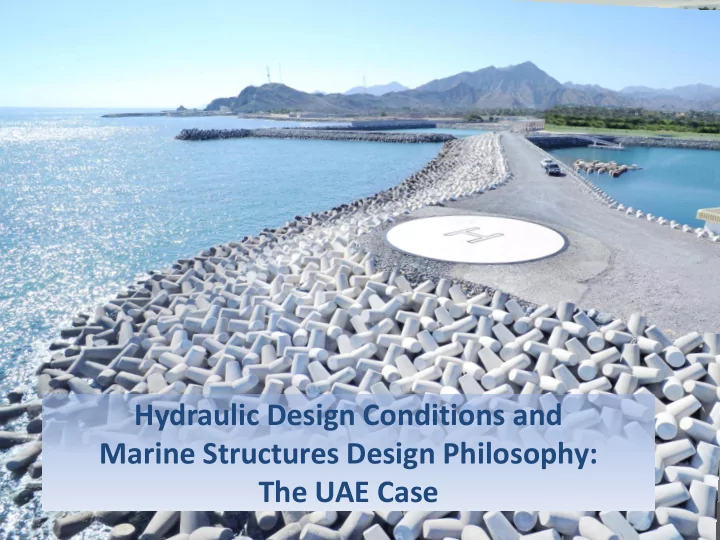

Hydraulic Design Conditions and Marine Structures Design Philosophy: The UAE Case
Hydraulic Design Conditions and Marine Structures Design Philosophy: The UAE Case AM Marine Works: Cypriaan Hendrikse, MSc. CDR International: Dirk Heijboer, MSc.
Overview of Presentation Hydraulic Design Conditions and Marine Structures Design Philosophy: The UAE Case 1. Hydraulic Design Conditions at both Gulfs - Dealing with Cyclones 2. Breakwater Design Philosophies – Gulf of Oman and Persian Gulf 3. Berm Shape Breakwaters and Porous Berm Designs 4. UAE Developed CRABLOCK TM for Sea Defences and Breakwaters
Hydraulic Design Conditions Hydraulic Design Conditions are mainly related to: • Water levels • Currents (tidal and wave driven) • Waves Main wave types that are generally relevant are: 1. Short Waves or Sea Waves, driven by nearby wind fields, having wave periods 4 – 8 seconds 2. Long Waves or Swell Waves, originating from large distance remote ocean storms, wave periods 8 – 20 seconds 3. Infra -Gravity Waves, extremely long waves with periods, wave periods of 20 – 200 seconds. Last waves important for oscillation in ports and coastal processes.
Hydraulic Design Conditions Shamals Long waves (infragravity waves) Cyclones
Gulf of Oman and Arabian Sea typical characteristics: 1. Close to deep water 2. Limited tidal effects 3. Limited storm surges most of the time 4. Occasionally affected by tropical storms or cyclones (e.g. GONU 2007 and PHET 2010): this requires refined statistical methods and design philosophy 5. Long oceanic swells affecting wave conditions in harbors 6. Occurrence of long waves (infra-gravity waves) 7. Ocean currents
Arabian Gulf: 1. Tide is dominated most of the time 2. Shamals cause large (locally generated) waves, currents and surge levels 3. Shallow water requires coupling of wave and flow mathematical models
Hydraulic Design Conditions Waves and their incoming directions important to know accurate for marine structures (breakwaters, revetments) and their chance on occurrence: 1. Nowadays 1:200 year design conditions, implying about 60% chance the event happens in a period of 200 years 2. All based on statistics, data-sets and hind-cast modelling (waves calculated from recorded winds speeds) over 30 to 40 years 3. What about unique events like cyclones, what is their return period ? They happened (Gonu in 2007, Phet in 2010) after many decades of absence. 4. What is climate change bringing us more? This demands better understanding of dealing with statistics not just a ‘Design Wave of 1/200 year’ based on extrapolation.
Structural Designing
Structural Designing
Structural Designing Structural Responses to the waves and their types is becoming more important: 1. Stability calculations not too complex in the UAE, typical waves are not extremely high in the UAE (Hsig 4 to 5 m) 2. Waves overtopping the structures (revetments and breakwaters) is becoming more and more an issue 3. For the armouring of structures can be chosen for larger rocks or concrete elements (Accropodes, Core-locs, Xblocs, Crablocks) 4. How to design for cyclone attack from Gulf of Oman? No damage or ‘allowable damage’ in combination with reasonable repair options in case such an event happens ? Consultants should explain the Clients and show the consequences (in the design and the costs) of the options
Structural Designing
Structural Designing Frequently Recurring Marine Design Aspects: 1. Rock supply is major cost item with respect to logistics, purchase and quality, which has to be thoroughly sorted out in the design 2. Wave overtopping behavior strongly relates to the geometry of the cross- section and armouring type (rock or concrete) and is often a major design issue 3. Design change requests by Clients at a late engineering stage or during construction demand flexibility in design philosophy and rapid consultancy response 4. Design tools (e.g. mathematical modelling) seems to be easy and produce colorful output, but thorough analyses of the input, calculation method and critical review of output should not be lacking 5. Specialists with combined scientific and site knowledge are scarce but essential for obtaining the best design
Berm Breakwaters Berm Breakwaters typical characteristics: 1. Demand more construction materials, but less heavy armour rock 2. The berm can be made porous, effectively reducing overtopping, in particular with concrete armour units (high porosity) 3. With rock armouring, some reshaping can be allowed in extreme events, e.g. cyclones (S-shape front will develop)
Alternative Concrete Armour Unit
The Crablock TM
The Crablock TM The Crablock Development 1. A single layer conrete block 2. Less chance on rocking (3 points support) 3. Less chance on downward shift on slope (settlement) 4. To be placed by excavator and no wire-crane 5. Rapid placement time 6. Underwater no divers required due to unambiguous placement procedure 7. Good stacking possibility, minimal stockpiling yard 8. Minimal sharp edges, easy to cast and less surficial damage 9. Stability guaranteed by weight and interlocking 10. Excellent porosity performance, reducing wave overtopping 11. Smaller sized rock underlayer 12. Attractive regular appearance
The Crablock TM
The Crablock TM
The Crablock TM
The Crablock TM
Concluding Remarks Consultants should focus nowadays more on Value Engineering: 1. Better insight in boundary conditions and statistics gives more flexibility in design philosophies, more to explain and to optimize for Clients 2. Less ‘copy - paste’ approach should be shown in the designs, more taylor- made designs need to be made, no un-necessary tight specs 3. More involvement of well experienced experts from site operations need to be taken into account in the design studies, building techniques are developing ‘everything is possible’ (Design -Construct) 4. Creating additional value of marine structure lay-outs and designs by creative and multi-disciplinary thinking (leisure, urban development, architectural) 5. Let the designs be reviewed by a third party for correctness, cost optimizations and development of even ‘smarter’ solutions 6. Early contractor involvement: because optimal design and construction methods are very closely related
THANK YOU Hydraulic Design Conditions and Marine Structures Design Philosophy: The UAE Case
Recommend
More recommend